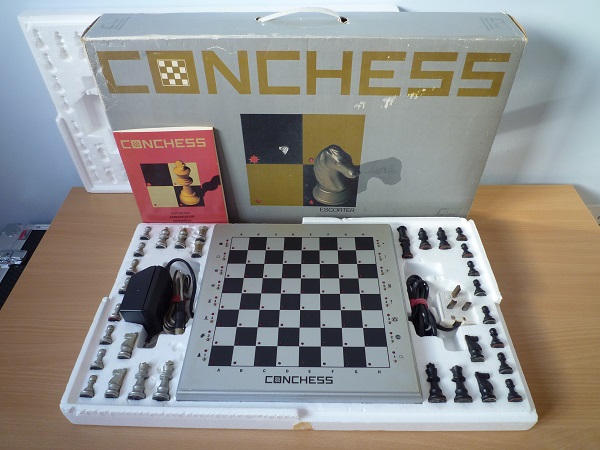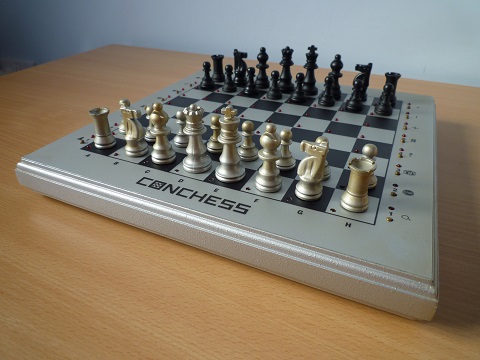|
The Ambassador and Monarch are the Conchess machines that get all of the attention. In particular the Monarch is a tournament size board in attractive veneer which catches the eye. Most sales on Ebay are of Ambassadors or Monarchs. In 1983 the prices were £249 for the Monarch, £199 for the Ambassador and £159 for the Escorter, whether the Escorter was in silver and copper, as above, or in silver and black (see photos at the bottom of the page).
The Escorter is arguably the rarest of the three, which all share the same electronics. Even so the Escorter would not justify a place in this RARE feature without the additional program modules.
Shown in the Escorter, labelled with a P is the Princhess (or Glasgow) module. Also known as the A1 in the UK. The second module in the Escorter, shown with a A0 sticker, is a modified standard program module. This had to be sent back to the factory for modification so that the A0 and auxiliary module A1 could work together. The document (bottom left) explains that this program won the World Microcomputer Chess Championships at Glasgow in 1984. It does not mention that the Princhess program was actually in a tie with Fidelity and Mephisto programs and Richard Lang’s Psion (link to tournament table). The Princhess program was sold in the A0/A1 format running at 2 MHz, and also in single modules running at 4 MHz, 6 MHz and 8 MHz. All of these modules included a larger opening book also available separately in a ‘Library’ module (L).
Next to the A0 and A1 in the photo is a module with an A 5.5 sticker. The document (bottom left) indicates that this is an A2 (in the UK) module. This has the Plymate (or Amsterdam) program from 1985 running at 5.5 MHz. Plymate modules were originally made available in 2 MHz, 6 MHz and 8 MHz versions with a later version of the program running at 5.5 MHz replacing the 6 MHz. Most A2’s sold in the UK would have been the 2 MHz module shown with the ‘C’ (see right), or the later 5.5 MHz version (above right). The fastest version, the T8 (the module without a cover shown to the right), cost a whopping £374.99 in 1985. Approaching £1000 at todays prices! Price and the fact that stronger machines were continually reaching the market in the 1980s is the reason these modules were poor sellers and are rare today. The L openings module is also shown (right).
The photo (below right) of the bottom of the Escorter shows the standard program module which has the same serial number as the Escorter itself (E0004686). The module serial numbers starting with an E were sold with an Escorter, A with an Ambassador and M with a Monarch. However regardless of whether the module is an E, A or M, it contains the same standard program and works in all three boards.
If you require more information about the program modules a 12 page Technical Guide can be downloaded from Alain Zanchetta’s website (link). This includes an Operating Guide for the Plymate cartridges.
An earlier rare version of the Operating Guide which covers the Princhess cartridges can be found here (link). Comparing the two guides will give you an easy way to distinguish between a Princhess and a Plymate cartridge using the Mate in x search function.
|

